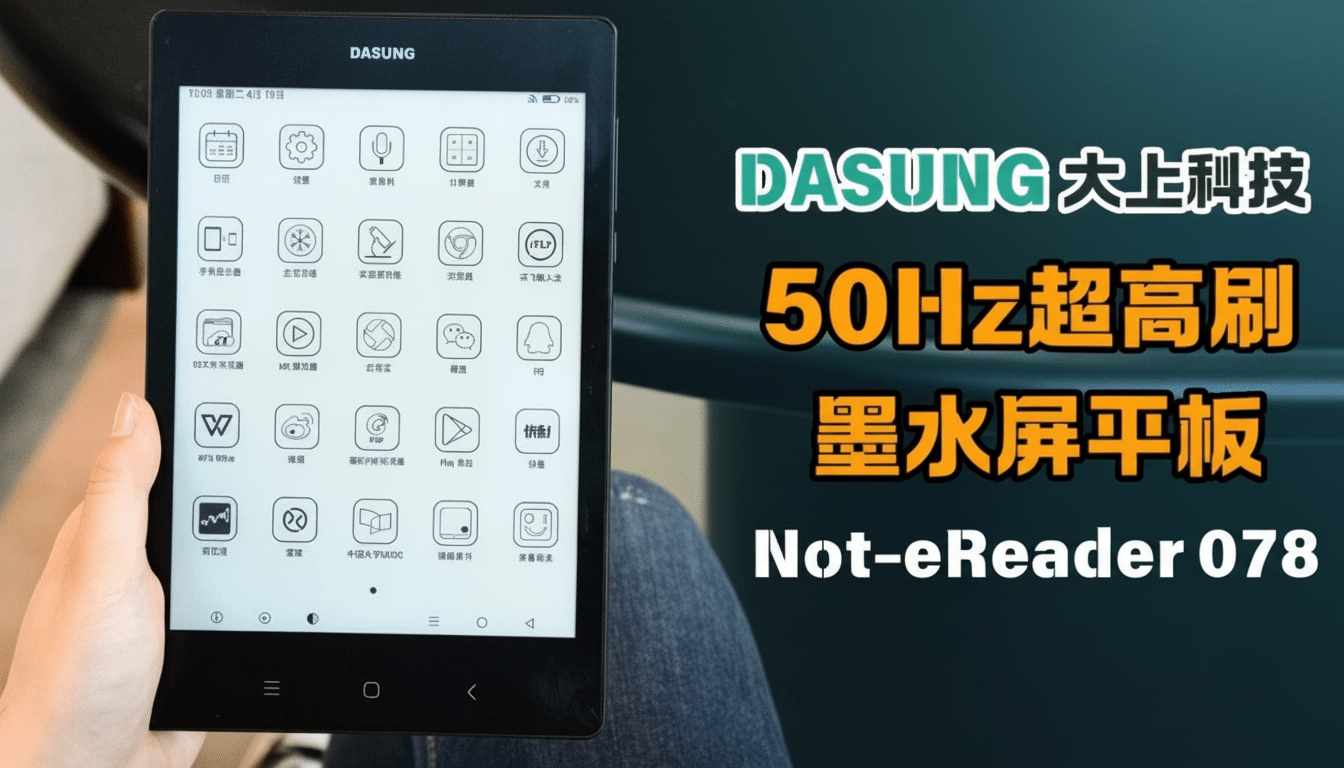There’s a new e-reader trying to break into the Amazon Kindle and Kobo cycle, as e-ink expert DASUNG previews its Not-eReader “Revolutionary Edition” that may run Android and drive E Ink response to a stated 50Hz. If true, that is one hell of a jump for e-paper with smoother scrolling and UI animations, and less ghosting than today’s mainstream readers.
A Big Bet on Faster E Ink for Smoother, Fluid Motion
In DASUNG’s teaser we can see two models, a smaller 7.8-inch model and a bigger 10.3-inch model intended for larger-format reading and note-taking. Its headline feature is a 50Hz refresh rate over E Ink, where most devices tend to be focused on crisp static pages rather than fluid motion. Where 60Hz is table stakes for LCDs and OLEDs, e-paper’s strength has always been its readability and efficiency; closing the gap on motion would be a real hurdle to clear.

Context matters here. E Ink Corporation’s Carta 1200 platform, its most recent, has claimed a 20% faster response time and improved contrast versus prior generations, and vendors like Onyx have piled on proprietary regimens of acceleration to make scrolling and handwriting feel snappier. Manufacturers don’t often post refresh-rate numbers in hertz, and so DASUNG’s mention of 50Hz stands out as a tease that invites skepticism until other people get their hands on the thing for a final say on eyestrain.
Android on E-paper: The Game-Changing Play
Being Android-based can make for a very different e-reader. Users can do more than buy books from a solo shop: install library apps, RSS readers, note apps, language tools, and distraction-free writing software. That kind of flexibility is what has made Android-based e-ink devices so alluring for so long, and it’s where Amazon’s closed platform continues to lag—even if the Kindle remains in an entirely different league as an actual bookstore, with battery life that just doesn’t quit, and a UI that doesn’t, either.
Early rumors, surfaced by ITHome, suggest that DASUNG’s Revolutionary Edition may come with 4GB of RAM, 64GB of storage, and a 5,600mAh battery. Those numbers are unverified and there’s no processor or Android version mentioned. With the history of Not-eReader models, it is habitual to try to conceal boundaries between e-reader, tablet, and even auxiliary display. Interestingly, ITHome claims the new models could eschew independent monitor functionality, signaling a greater focus on mobile-first use this time around.
How It Would Compare to Kindle and Kobo E-readers
Amazon’s top-selling readers highlight long battery life, high pixel density, and a mature reading ecosystem with features like waterproofing, synced highlights, and reliable Whispersync. Kobo offers support for wide formats, OverDrive integration in most countries, and competitive hardware. Each uses the same sort of conservative refresh as adjusted for page-flipping rather than ongoing movement.
If DASUNG is telling the truth about 50Hz, the practical victories would be found in web articles, comic pages, annotation workflows, and UI navigation—all areas of current e-readers that can sometimes feel sluggish. The trade-off is predictable: faster refresh translates to more screen updates, and E Ink burns a lot of power when pixels change. For a long time, E Ink forums have noted that static content uses little power; constant updates do not. Managing battery power, thermal limits, and contrast retention will be the engineering challenge.

Price, Performance, and the Trust Gap for Faster E Ink
Excitement on Reddit is tempered with a dose of reality: The idea to improve upon the reMarkable and create smoother e-paper has people hyped, but there are questions as to whether 4GB/64GB will work for multitasking; we were eager to get more in our review.
The company’s niche gear, such as its Paperlike e-ink monitors, has come with premium pricing in the past. There’s no clear processor roadmap or timing for launch yet, so it’s hard to know exactly where this device will fall in the market next to Android-first rivals like Onyx and Bigme, or more traditional readers from Amazon and Kobo.
There’s also the question of panel quality. Speccing the responsiveness beyond that can result in trading away some contrast or adding more artifacts. That’s where E Ink makes its own progress, but results vary for any given vendor implementation. Until reviewers are in the position to test text clarity, ghosting mitigation, and note latency across various refresh modes, 50Hz is an interesting figure, rather than one based on concrete evidence.
What to Watch Next as DASUNG Reveals Key Details
Key details still missing include price, chipset, Android version, and the final feature set. If the larger model offers stylus support and low latency for handwriting, while the smaller one nails one-handed ergonomics, DASUNG might be able to carve out two different exciting niches. Whether the devices support Google Play natively (or instead defer to other app stores) will also play a part in how much allure these options hold.
For now, the signal is clear: e-paper is approaching more flexible app-friendly experiences without abandoning its foundation. If DASUNG can provide a significantly faster, Android-driven reader without compromising readability or battery life, it wouldn’t just be another Kindle alternative—it might reset expectations about what an e-reader can accomplish when page-turn speed isn’t the overriding concern.

